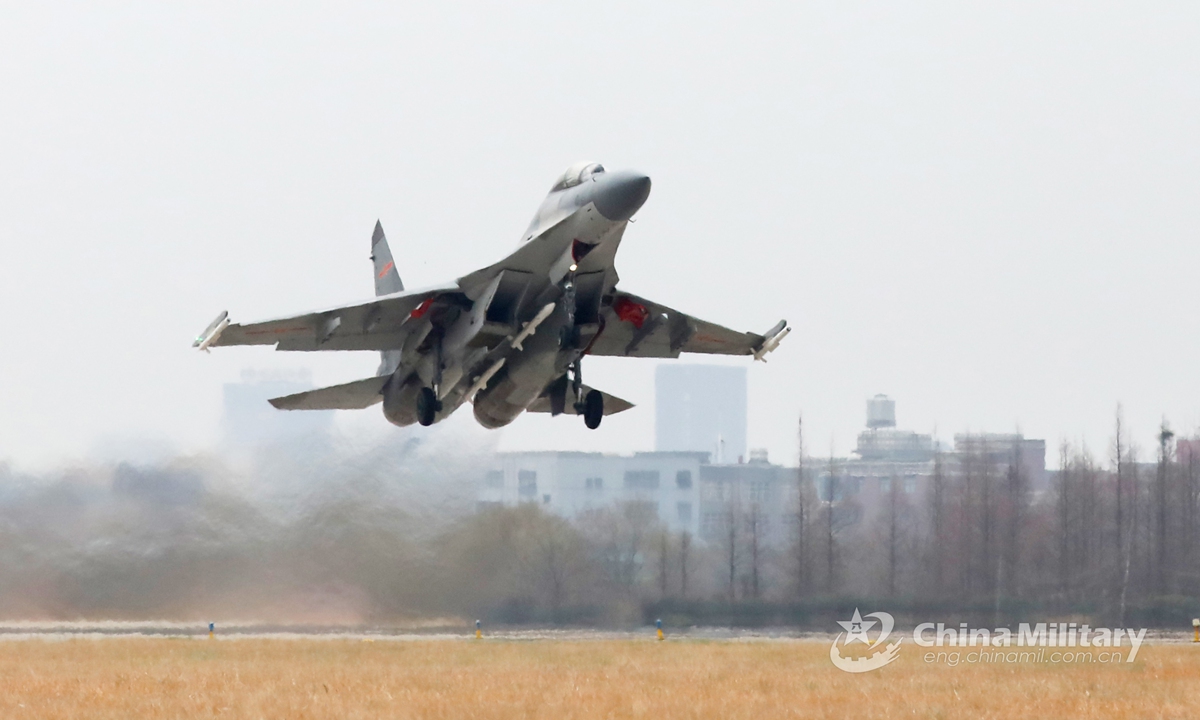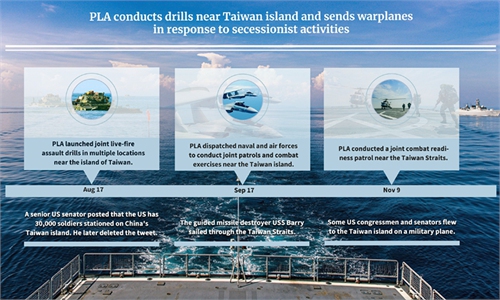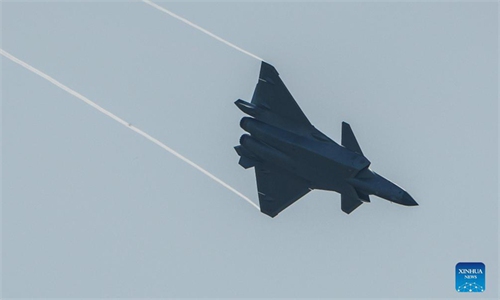Taiwan’s new submarine, warplanes cannot change widening military gap with mainland: experts

A J-16 fighter jet attached to an aviation brigade of the air force under the PLA Eastern Theater Command takes off from the runway during multiple training sorties on February 16, 2021.Photo:China Military
The island of Taiwan will reportedly usher in new progress on several types of weapons and equipment, including the island's first indigenous submarine prototype, F-16V fighter jets and an advanced supersonic jet trainer. However, no matter how the island develops or purchases arms, the great disparity in military strength across the Straits cannot be changed, said experts, warning that resisting reunification by force is bound to meet a dead end.
Local media on the island reported Sunday that a keel-laying ceremony for Taiwan's first indigenous submarine prototype was scheduled for Tuesday.
Keel-laying is a very early stage of the ship's construction, and will take a long time before it is ready, observers said.
Taiwan has limited technological capacity for independent construction, and Taiwan's shipbuilding industry will face huge challenges in developing the submarine, a Beijing-based military expert told the Global Times on condition of anonymity on Monday. It cannot be ruled out that the US could raise the price to transfer its technology to help Taiwan in the construction, the expert noted.
Even if the ship is eventually finished, the Chinese People's Liberation Army (PLA) will continue to extend its lead in submarine and anti-submarine technology, said the expert.
The mainland now possesses very strong capabilities in anti-submarine warfare, Wei Dongxu, a Beijing-based military expert, told the Global Times, noting that many mainland warships are equipped with towed sonar systems, anti-submarine warfare helicopters and torpedoes, plus the land-based Y-8 anti-submarine warfare aircraft.
According to Taiwan's defense authority, the Y-8 anti-submarine warfare aircraft is one of the most frequent visitors to the Taiwan Straits recently, which according to experts shows the mainland is paying close attention to submarine activities around the Straits.
Taiwan's regional leader Tsai Ing-wen will host a ceremony on Thursday when the island's first F-16V combat wing will be officially commissioned in the Chiayi Base in southern Taiwan, Taiwan media said.
As the upgraded version of the F-16, the F-16V has a more advanced radar system and its load capacity and range has improved. But it is a non-stealth fighter which is weak in the face of advanced early warning systems and anti-aircraft fire, Wei said.
No matter how they improve, the enhancement the F-16V received in combat capabilities is very limited, Wei said. Compared to PLA warplanes like the J-20 stealth fighter and the J-16 heavy fighter, the F-16V has little chance of winning, Wei said.
Modern warfare is a systematic joint operation. Taiwan's aircraft would be hard-pressed to take off from the airport, and would be blown up on runways and in hangars by the PLA, experts said.
Taiwan's potential plan to upgrade the combat wing will merely be another opportunity for the US to cheat Taiwan out of their money, Wei noted.
The first Taiwan-made advanced jet trainer T-5 Brave Eagle will be delivered to the island's air force this month. The T-5 Brave Eagle will replace the F-5 as the air force's primary training aircraft, Taiwan media reported.
Experts explained that the advanced jet trainer does not provide much direct help to the aircraft in combat, as it just trains pilots.
The experts questioned the effectiveness of the new trainer aircraft as both aircraft equipment parts and pilots will be worn out from just coping with the PLA's routine exercises.
The gap in military strength between the Chinese mainland and the island of Taiwan will become even wider by that time, experts said.
No matter how Taiwan develops or purchases arms, it cannot change the military disparity across the Taiwan Straits, they stressed, warning Taiwan secessionists that resisting reunification by force is bound to meet a dead end.



